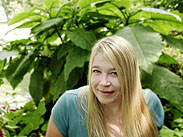In focus
Mélanie Vincelette: Hitting the books
Mélanie Vincelette has an unassuming, friendly demeanour that belies her drive. She is an entrepreneurial and creative maverick, managing a three-fold career as a student, a writer and — to impressive success — a publisher. She carries in her briefcase her doctoral thesis (on the courtesan in French literature), a copy of her second book, Qui a tué Magellan et autres nouvelles, and four others she has helped bring into the world

Claudio Calligaris
"I publish books that I love," says Vincelette, founder of Les Éditions Marchand de Feuilles and McGill doctoral student in the Department of French Language and Literature.
Eric Dupont, whose first novel is being released by Marchand de Feuilles this fall, tells of Vincelette's determination, describing her reaction when she received his manuscript: "Mélanie didn't just want it, she demanded it."
Vincelette describes her first reading of Voleurs de sucre as one would a coup de foudre. "It's very different... It's funny... It's beautifully written." But at first it seemed that her love for the confessional story of a three-year-old sugar addict would remain unrequited.
By the time Dupont (who teaches translation in McGill's Continuing Education Depart-ment) found Marchand de Feuilles, his first novel had already attracted the attention of four other publishers. But he was left at the altar again and again as one deal after another was quashed. One small publisher, a week before his contract was to be signed, left him for a more lucrative market in textbooks. Another asked him to change his protagonist's age from three to seven. Since his creative goal was to bring the reader back to early, preliterate childhood, this broke the deal, and Voleurs de sucre was happily scooped up and dropped into the waiting arms of Marchand de Feuilles.
Publishing in Quebec is a tough business. Explains Vincelette, "There are a lot of small houses, but the problem is that three major ones take up all the market." Larger companies look for recognizably Québecois voices: Dupont was asked by one publisher to insert joual into his text — another change that did not suit his creative MO in the least.
It was just this kind of frustrating experience that led to the formation of Marchand de Feuilles. Three years ago, after she and two friends, writers Suzanne Myre and Véronique Bessens, tallied up their rejection slips, Vincelette took matters into her own hands and successfully applied for grants from La Fondation du maire de Montreal and Le Fonds Jeunesse Québec to print three books: Petites geographies orientales, Un train en cache un autre and Nouvelles d'autres mères.
Since then, she and her authors have never looked back: Myre's first novel, Nouvelles d'autres mères, won Le Grand Prix Radio-Canada, Ransom House is interested in a translation, and her third novel was on Renaud-Bray's top-seller list for three weeks.
A recently signed contract between Marchand de Feuilles and a French distributor also bodes well. Still, when Vincelette went to France to accept Le Prix de Jeune Écrivain, the French were not as encouraging of her second career. "They called me 'Mélanie the publisher,' as a joke." Well, tant pis. "Mélanie the publisher" is launching 10 books this year.
It's fitting that Marchand de Feuilles enjoys success abroad. Vincelette has long been attracted to the real and literary worlds outside Quebec. Her master's thesis dealt with French travel writing of the 17th century, and her first book of short stories explored her experiences in southeast Asia. Indian authors speak to her vividly. "They write in images, and they write in contrasts. And they have this sensibility that's really connected to mine. They show, they don't tell. And I think here [in Quebec] it's the reverse," she says.
Studies at McGill have been intrinsic to her creative work, particularly classes with Yvon Rivard, who encouraged her to send her short stories to literary reviews. "He helped me a lot with my writing. Without him, I don't think I would have tried to publish my work. He told me, 'Writers write, and have to do it every day. If you really want to be a writer, you'll become one.'"
Vincelette says she finds it puzzling when people refer to arts degrees as impractical. "I don't see it that way. [With an arts degree] you can do whatever you want: you can translate, you can be a journalist, you can work in publishing. It's not that hard to do something with your degree when you're in arts or in literature. I'm convinced of that."
Go to www.marchanddefeuilles.com or call 845-9678 for more info. Fall releases also include Eva Rollin's Mademoiselle, and Komsomolets by Jade Bérubé. Voleurs de sucre will be launched on September 24, 6 pm, at Galerie Parchemine, 40 Saint Paul Ouest.
 |
||||
|
It's part of our Freudian obsession. We want the kids as a window into who is the true George Bush, who is the true John Kerry. |
||||
Meteorology on cloud nine
A new study by McGill physicist Shaun Lovejoy has shed light on an old meteorological problem: how to measure the volume of a cloud. Satellites can estimate length and breadth, but accurately measuring cloud depth requires the use of weather balloons, which are notoriously unreliable. As a result, meteorologists have had to consider clouds as flat, two-dimensional structures — a notion that limits the accuracy of weather forecasts. Using new laser technology, Lovejoy and his colleagues have created a formula that allows scientists to calculate the size of any cloud — a breakthrough that may improve weather forecasts and our understanding of global warming.

Jack Ruttan
"Describing clouds as two-dimendional vastly simplifies weather prediction mathematics, but the assumption is naive," explained Lovejoy. Cloud depth is constrained by the thickness of the Earth's atmosphere — a cloud 2000 km in length and breadth cannot be 2000 km in depth because the Earth's atmosphere is only 10 km thick. Although clouds appear progressively flatter as their volume increases, they never become truly two-dimensional.
Armed with new lidar technology — an airplane-mounted laser device capable of measuring the size, speed and chemical composition of clouds — Lovejoy and his colleagues initiated the mother of all cloud studies. "We completed nine lidar sections of pollution smog over British Columbia and the northwestern United States," said Lovejoy. "Each section contained nearly one hundred times the data of the largest comparable weather balloon experiment." From these data, the research team created a mathematical formula that predicts how cloud depth changes in relation to length and breadth. "We can now estimate the volume of all clouds, from the largest cyclone to the smallest puff of a car exhaust," said Lovejoy.
The research, published in last month's Physical Review journal, could significantly improve our short-term weather forecast. But modelling the behaviour of wind-driven particles in three dimensions requires some pretty lofty mathematics, so changes to the current algorithms are unlikely to occur overnight. An additional implication of this research involves global warming predictions. Water vapour, in the form of clouds, accounts for over half of the greenhouse effect. "An improved knowledge of clouds is key to understanding solar radiation interaction in our atmosphere," said Lovejoy. "This research allows us to better estimate the effects that clouds have on our planet."
 |
||||
|
The cancer cells just stopped. |
||||
